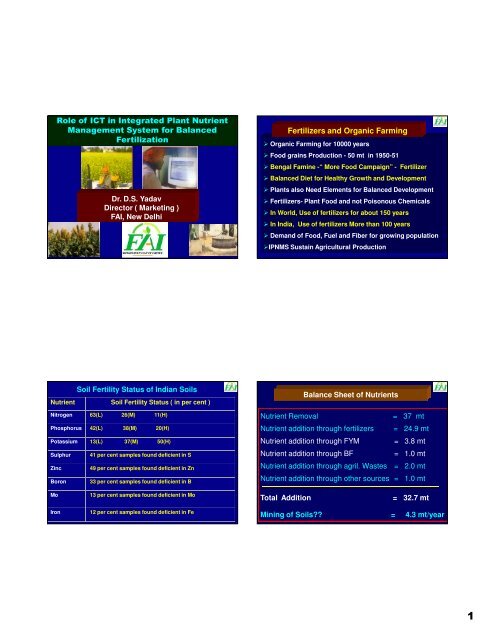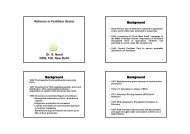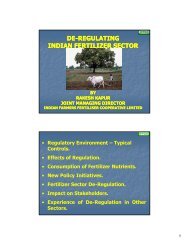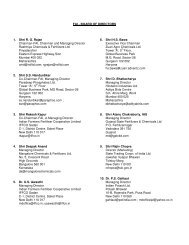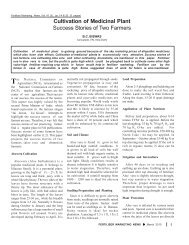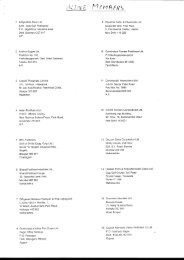Role of ICT in Integrated Plant Nutrient Management System for ...
Role of ICT in Integrated Plant Nutrient Management System for ...
Role of ICT in Integrated Plant Nutrient Management System for ...
Create successful ePaper yourself
Turn your PDF publications into a flip-book with our unique Google optimized e-Paper software.
<strong>Role</strong> <strong>of</strong> <strong>ICT</strong> <strong>in</strong> <strong>Integrated</strong> <strong>Plant</strong> <strong>Nutrient</strong><br />
<strong>Management</strong> <strong>System</strong> <strong>for</strong> Balanced<br />
Fertilization<br />
Dr. D.S. Yadav<br />
Director ( Market<strong>in</strong>g )<br />
FAI, New Delhi<br />
Fertilizers and Organic Farm<strong>in</strong>g<br />
Organic Farm<strong>in</strong>g <strong>for</strong> 10000 years<br />
Food gra<strong>in</strong>s Production - 50 mt <strong>in</strong> 1950-51<br />
Bengal Fam<strong>in</strong>e -“ More Food Campaign” - Fertilizer<br />
Balanced Diet <strong>for</strong> Healthy Growth and Development<br />
<strong>Plant</strong>s also Need Elements <strong>for</strong> Balanced Development<br />
Fertilizers- <strong>Plant</strong> Food and not Poisonous Chemicals<br />
In World, Use <strong>of</strong> fertilizers <strong>for</strong> about 150 years<br />
In India, Use <strong>of</strong> fertilizers More than 100 years<br />
Demand <strong>of</strong> Food, Fuel and Fiber <strong>for</strong> grow<strong>in</strong>g population<br />
IPNMS Susta<strong>in</strong> Agricultural Production<br />
Soil Fertility Status <strong>of</strong> Indian Soils<br />
<strong>Nutrient</strong> Soil Fertility Status ( <strong>in</strong> per cent )<br />
Nitrogen 63(L) 26(M) 11(H)<br />
Phosphorus 42(L) 38(M) 20(H)<br />
Potassium 13(L) 37(M) 50(H)<br />
Sulphur 41 per cent samples found deficient <strong>in</strong> S<br />
Z<strong>in</strong>c 49 per cent samples found deficient <strong>in</strong> Zn<br />
Boron 33 per cent samples found deficient <strong>in</strong> B<br />
Balance Sheet <strong>of</strong> <strong>Nutrient</strong>s<br />
<strong>Nutrient</strong> Removal<br />
= 37 mt<br />
<strong>Nutrient</strong> addition through fertilizers = 24.9 mt<br />
<strong>Nutrient</strong> addition through FYM = 3.8 mt<br />
<strong>Nutrient</strong> addition through BF = 1.0 mt<br />
<strong>Nutrient</strong> addition through agril. Wastes = 2.0 mt<br />
<strong>Nutrient</strong> addition through other sources = 1.0 mt<br />
Mo<br />
13 per cent samples found deficient <strong>in</strong> Mo<br />
Total Addition<br />
= 32.7 mt<br />
Iron<br />
12 per cent samples found deficient <strong>in</strong> Fe<br />
M<strong>in</strong><strong>in</strong>g <strong>of</strong> Soils?? = 4.3 mt/year<br />
1
Why Integration ?<br />
Multiple <strong>Nutrient</strong> Deficiencies<br />
Higher Productivity and Cropp<strong>in</strong>g Intensity <strong>in</strong> Irrigated Areas<br />
Organic Sources Insufficient <strong>for</strong> Nutritional Needs <strong>of</strong> HYVs<br />
Organic Sources with Fertilizers Became Necessary<br />
Organic Sources- no. <strong>of</strong> Animals a Farmer Possess<br />
50 per cent <strong>of</strong> Dung Used as Fuel<br />
Alternative Source <strong>of</strong> Energy <strong>for</strong> Farmers<br />
Green Manur<strong>in</strong>g- Loose one Crop<br />
Lack <strong>of</strong> Soil Moisture <strong>for</strong> its Decomposition<br />
A Need <strong>of</strong> Integrat<strong>in</strong>g Organic Sources with M<strong>in</strong>eral Sources<br />
FYM, Green Manure, Crop Residues, N-Fix<strong>in</strong>g Bacteria, BGA<br />
Organic Sources Supplement <strong>Plant</strong> <strong>Nutrient</strong>s Need<br />
Susta<strong>in</strong>able Agriculture<br />
Successful management <strong>of</strong><br />
resources<br />
Satisfy the chang<strong>in</strong>g human<br />
needs<br />
Ma<strong>in</strong>ta<strong>in</strong> or enhance the quality<br />
<strong>of</strong> environment<br />
Conserve natural resources<br />
Rice-Wheat Cropp<strong>in</strong>g <strong>System</strong><br />
IPNMS <strong>for</strong> Desired Yield<br />
Balanced Fertilization<br />
10 Tonnes <strong>of</strong> Food gra<strong>in</strong>s/ha <strong>in</strong> Ludhiana<br />
Remove 500 to 700 kg <strong>Nutrient</strong>s/ha/year<br />
BF Supply not more than 15-30 kg N or P 2 O 5 per ha<br />
Complimentary Sources <strong>of</strong> <strong>Plant</strong> <strong>Nutrient</strong> N / P<br />
Reverse the ill Effect <strong>of</strong> Soil M<strong>in</strong><strong>in</strong>g <strong>of</strong> <strong>Nutrient</strong>s<br />
Promot<strong>in</strong>g Tenets <strong>of</strong> Susta<strong>in</strong>able Agriculture<br />
Response <strong>of</strong> Fertilizers Decl<strong>in</strong><strong>in</strong>g due to<br />
Sub-optimal and Imbalance <strong>in</strong> Fertilizer Use<br />
Inappropriate Methods and Time <strong>of</strong> Application<br />
Lesser Use <strong>of</strong> Organic Manure<br />
IPNMS Must <strong>for</strong> the Desired Results<br />
2
The Key Objectives <strong>of</strong> IPNMS<br />
To ma<strong>in</strong>ta<strong>in</strong> or enhance soil productivity through<br />
balanced use <strong>of</strong> fertilizers comb<strong>in</strong>ed with<br />
organic and biological sources <strong>of</strong> plant nutrients<br />
To improve the stock <strong>of</strong> plant nutrients <strong>in</strong> the soil<br />
Major Sources <strong>of</strong> <strong>Nutrient</strong>s<br />
Component Desirable effect Other effect<br />
Fertilizers Concentrated source No Micronutrients<br />
Organic manure<br />
Green manure<br />
Less nutrients but Improves<br />
soil physical properties<br />
Sources <strong>of</strong> N from the<br />
atmosphere<br />
Crop residues Source <strong>of</strong> K. Mulch<strong>in</strong>g has +<br />
ve effect on soil properties<br />
Immediate crop need not met<br />
Crop competition<br />
Immobilization <strong>of</strong> nutrients<br />
More fertilizer needed.<br />
<br />
To improve the efficiency <strong>of</strong> plant nutrients<br />
Crop rotation<br />
(other crop -<br />
legume)<br />
N fixed by legumes<br />
Improves soil permeability<br />
little N fixed available to the<br />
succeed<strong>in</strong>g crop<br />
To improve physical conditions <strong>of</strong> soils<br />
Rhizobium,<br />
Azospirillum. and<br />
BGA<br />
Mycorrhiza and P<br />
solubilisers<br />
N fixers<br />
P solubilizers<br />
Small amount <strong>of</strong> N fixation<br />
Small amount <strong>of</strong> P solubilized<br />
IPNMS <strong>in</strong> Farmer’s Hand<br />
All Sources <strong>of</strong> <strong>Plant</strong> <strong>Nutrient</strong>s<br />
Fertilizer<br />
BF<br />
FYM<br />
Organic Wastes<br />
Compost<br />
Fertilizers<br />
Bi<strong>of</strong>ertilizers<br />
BGA<br />
3
Organic Sources<br />
Animal Dung Human Excreta, Recycl<strong>in</strong>g <strong>of</strong> <strong>Plant</strong> Resources and City<br />
Wastes<br />
Organic Sources Neither <strong>Nutrient</strong> Specific nor Concentrated Sources<br />
For Nutritional Benefits, Organic Sources to be Decomposed<br />
Microorganisms Eng<strong>in</strong>eer Their Break Down<br />
Temperature and Moisture Conditions Influence the Decomposition<br />
C: N ratio Decides the Time Lag <strong>for</strong> <strong>Nutrient</strong>s to Become <strong>Plant</strong> Usable<br />
<strong>Nutrient</strong> Supply from Organic Sources Rema<strong>in</strong>s low, Variable and<br />
Uncerta<strong>in</strong><br />
Second Largest Population ( About 110 crores)<br />
Higher Number <strong>of</strong> Livestock (about 500 Millions)<br />
Seventh Largest Geographical Area (329 Million ha)<br />
A Vast Pool <strong>of</strong> Organic Manure <strong>for</strong> <strong>Nutrient</strong> Availability<br />
Organic Manure Potential = 16.9 Million Tonnes <strong>of</strong> NPK<br />
85 per cent Arises from Animal Dung, Crop Residues and Human Excreta<br />
About 5.65 mt NPK Available <strong>for</strong> Agricultural Use<br />
Chemical Composition <strong>of</strong> Organic<br />
Sources<br />
Organic<br />
Sources<br />
Primary nutrients (%)<br />
N P K<br />
FYM 1.0 0.5 0.9<br />
Poultry 1.9 1.9 1.6<br />
Human<br />
Excreta<br />
City<br />
compost<br />
Wheat<br />
straw<br />
1.6 0.5 0.5<br />
1.5 0.5 1.0<br />
0.6 0.1 1.6<br />
Some projections on the availability <strong>of</strong> NPK (mt)<br />
from some organic resources - 2005-2025<br />
Resources 2005 2010 2025<br />
<strong>Nutrient</strong> (theoretical potential) <strong>in</strong> MT<br />
Human excreta ( N+P 2 O 5 +K 2 O) 2.00 2.24 2.60<br />
Livestock dung ( N+P 2 O 5 +K 2 O) 6.64 7.00 7.54<br />
Crop residues ( N+P 2 O 5 +K 2 O) 6.21 7.10 10.27<br />
Farm Yard Manure<br />
Spray Evenly<br />
Avoid Heaps <strong>of</strong> Compost<br />
Evaporation <strong>of</strong> N <strong>in</strong> Hot<br />
Atmosphere<br />
<strong>Nutrient</strong> (considered tappable) <strong>in</strong> MT<br />
Human excreta ( N+P 2 O 5 +K 2 O) 1.60 1.80 2.10<br />
Livestock dung ( N+P 2 O 5 +K 2 O) 2.00 2.10 2.26<br />
Crop residues ( N+P 2 O 5 +K 2 O) 2.05 2.34 3.39<br />
TOTAL 5.05 6.24 7.75<br />
4
Method <strong>of</strong><br />
Prepar<strong>in</strong>g good quality<br />
Compost<br />
- Fill the pit with<br />
Animal excreta and<br />
Farm waste at<br />
regular <strong>in</strong>terval<br />
Mix the Farm Yard Manure Well <strong>in</strong> Soil<br />
- Prevent the pit with<br />
direct Sun light<br />
Bio Gas- Source <strong>of</strong> Compost and Energy<br />
Bio Gas Slurry - a Good Manure<br />
Vermi Compost<br />
5
Animal Waste<br />
Human Waste<br />
Crop Wastes<br />
COMPOST<br />
Factory Waste<br />
( Press mud )<br />
Low Grade M<strong>in</strong>erals<br />
(i.e. Rock phosphate)<br />
Biomass <strong>of</strong><br />
uncultivated<br />
<strong>Plant</strong>s<br />
MSW 40-50 million MT<br />
Organic Manures 5-7 million MT<br />
Can we harness fully ??<br />
Recycl<strong>in</strong>g <strong>of</strong> Agricultural Wastes<br />
Crop residues – 1/3rd residue available <strong>for</strong> recycl<strong>in</strong>g<br />
Oil cakes from Oil extraction > Oil - 25 mt <strong>of</strong> oil seeds<br />
Biomass <strong>of</strong> weeds or uncultivated plants (water hyac<strong>in</strong>th, etc.,)<br />
Wastes from fruit / vegetable process<strong>in</strong>g factories<br />
Animal wastes – dung and ur<strong>in</strong>e generated from 500 million animal<br />
Excreta <strong>of</strong> 110 crore population<br />
Crop wastes due to post harvest losses<br />
Fruit/Vegetable wastes after consumption <strong>of</strong> the ma<strong>in</strong><br />
Sugarcane trash from 350 mt and 5-6 mt <strong>of</strong> press mud<br />
Recyclable Wastes<br />
Bulky Makes Storage, Handl<strong>in</strong>g, Transport and Application<br />
Difficult<br />
Time Consum<strong>in</strong>g, Inconvenient and Expensive<br />
Possibilities <strong>of</strong> Prepar<strong>in</strong>g Compacted, Briquetted or Pelleted<br />
Products<br />
Incorporation <strong>of</strong> <strong>Nutrient</strong>-Rich Natural M<strong>in</strong>erals, Fertilizers and<br />
Microbial Cultures<br />
Human Waste - Pathogens can Pose Serious Health Hazards<br />
Treat or Compost these wastes to Kill Pathogens<br />
Sewage and Sludge may Build up Heavy Metals to Toxic Levels<br />
Crop Residues with High C:N ratio Compete with Crop <strong>for</strong> N<br />
Transport and Application <strong>of</strong> Biogas Slurry may not be Practical<br />
Glass, Metal, Plastic, Wood, Cloth <strong>in</strong> Municipal and City Wastes<br />
6
Biological Agents Capable <strong>of</strong> Fix<strong>in</strong>g<br />
Nitrogen<br />
Symbiotic<br />
Legum<strong>in</strong>ous plants + Rhizobium<br />
Blue-green algae and water fern (Azolla) <strong>in</strong> rice fields<br />
Non-symbiotic<br />
Blue-green algae : Nostoc, Anabaena, etc.<br />
Bacteria : Aerobic - Azotobacter, Azospirillum, Bacillus,<br />
Polymyxa, etc.<br />
Anaerobic - Clostridium, Rhodosprillum,<br />
Clorobium, etc.<br />
Bio Fertiliser Cultures<br />
Atmospheric Nitrogen Fixation <strong>in</strong> Soil<br />
Legumes Fix Atmospheric N through Root Nodules<br />
Legume Seeds Inoculated with Suitable Stra<strong>in</strong>s <strong>of</strong> Bacteria<br />
7
Seeds and Bacterial Inoculant thoroughly Mixed<br />
Inoculated seeds not to be dried and sown immediately<br />
Green Manur<strong>in</strong>g <strong>of</strong> Legumes Add N and Improve<br />
Physical Properties <strong>of</strong> the Soil<br />
Addition <strong>of</strong> BGA Culture <strong>in</strong> Rice Fields can<br />
Contribute about 25 kg Nitrogen per ha <strong>for</strong> the Crop<br />
8
Fertilizer Companies <strong>in</strong> BF<br />
No. <strong>of</strong> Units Produc<strong>in</strong>g Bio-Fertilizers<br />
GSFC<br />
IFFCO<br />
RCFL<br />
CIL<br />
Units Capacity Production<br />
119 26,864 24,455<br />
MT<br />
BVFCL<br />
FACT<br />
KRIBHCO<br />
MFL<br />
NFL<br />
SPIC<br />
Suggestions <strong>for</strong> BF<br />
BF Extremely Sensitive to Changes <strong>in</strong> Environment<br />
Mutate very <strong>of</strong>ten and Degenerate with Frequent Renewals<br />
Bacterial count as Specified by BIS Standard<br />
Produce Region Specific BF<br />
Develop Ideal and Easily available Carrier <strong>for</strong> Increas<strong>in</strong>g Longevity<br />
Stability <strong>of</strong> BF aga<strong>in</strong>st Adverse Conditions<br />
Symbiotic Fixation not Free Nitrogen<br />
<strong>Plant</strong> has to Provide Energy <strong>in</strong> the <strong>for</strong>m <strong>of</strong> Photosynthates<br />
Whether a crop ‘Pays’ <strong>for</strong> Fixation yet to be Determ<strong>in</strong>ed<br />
Legumes require more P than Cereals<br />
Proper Pack<strong>in</strong>g, Transportation and Storage<br />
Intensive Promotional Activities Needed<br />
Unlike M<strong>in</strong>eral Fertilizers, BF is not a <strong>Plant</strong> Food.<br />
Liv<strong>in</strong>g Organisms Requires Careful <strong>Management</strong> and <strong>Nutrient</strong>s<br />
Rhizobium not to be Applied where Population already Sufficient<br />
Proper Survey <strong>of</strong> the Proposed Area<br />
Share <strong>of</strong> Fertilizers and Natural Sources<br />
<strong>in</strong> Total<br />
<strong>Nutrient</strong> Consumption - Ch<strong>in</strong>a<br />
Year<br />
Relative Share (%)<br />
Natural nutrient<br />
Fertilizers<br />
sources<br />
1965 22 78<br />
1975 33 67<br />
1985 56 44<br />
1995 68 32<br />
2005 75 25<br />
9
Some Fertilizer Equivalent <strong>of</strong> Organic Manures and<br />
Bio-fertilizes<br />
Component Input level Fertilizer equivalent <strong>of</strong><br />
<strong>in</strong>put <strong>in</strong> terms on crop yield<br />
Organic manure (FYM) per tonne 3.6 kg N +<br />
P 2 O 5 +K 2 O(2:1:1)<br />
Green manure (Sesbania) per tonne 4.4 kg N<br />
Green manure (Sesbania) 45 days crop 50-60 kg N <strong>for</strong> HYV rice<br />
Cowpea <strong>in</strong>tercropped with castor Legume buried 30 kg fertilizer N on castor<br />
Leucaenia lopp<strong>in</strong>g<br />
after 6 weeks<br />
88 kg N <strong>in</strong> Leucaenia-25 kg fertilizer N on sorghum<br />
Rhizobium Inoculants 19-22 kg N<br />
Azotobacter and Azospirillum Inoculants 20 kg N<br />
Blue Green Algae 10 kg/ha 20-30 kg N<br />
Azolla 6-12t/ha 3-4 kg/t<br />
Sugarcane trash 5 t/ha 12 kg N/t<br />
Rice straw + Water hyac<strong>in</strong>th 5 t/ha 20 kg N/t<br />
India - A Fact About Organic Farm<strong>in</strong>g<br />
Total Area Under Certified<br />
Organic Farm<strong>in</strong>g<br />
Wild Herb Collection<br />
Rest Crops<br />
Production <strong>of</strong> Organic Crops<br />
Tea contribute around 24 %<br />
Rice contribute around 24 %<br />
Fruits & Vegetables 17 %<br />
25.1 lakh ha<br />
24.3 lakh ha<br />
0.8 lakh ha<br />
14,000 MTs<br />
Certify<strong>in</strong>g Agencies <strong>in</strong> India<br />
Agri and Processed Food Export Development Authority<br />
Tea Board<br />
Spices Board<br />
C<strong>of</strong>fee Board<br />
Coconut Development Board<br />
Market Size <strong>of</strong> Organic Food World Over<br />
USA US $ 16.3 to 29.7 billion<br />
EU<br />
US $ 12 billion<br />
Germany 30 %<br />
UK 13 %<br />
Italy 12 %<br />
France 12 %<br />
Directorate <strong>of</strong> Cashew & Cocoa<br />
11 Accredited Certify<strong>in</strong>g Agencies <strong>of</strong> Netherland, Switzerland,<br />
Germany and Indocert <strong>in</strong> Kerala<br />
Japan<br />
Ch<strong>in</strong>a export<br />
US $ 40 crores<br />
US $ 14 crores<br />
1000 Ch<strong>in</strong>ese companies &<br />
farmers – Certified organic<br />
10
Why-Why Diagram <strong>for</strong> limited penetration Organic Agriculture <strong>in</strong> India<br />
Limited<br />
Penetration<br />
<strong>of</strong> Organic<br />
Agriculture<br />
<strong>in</strong> India<br />
Low Levels <strong>of</strong> Market<br />
In<strong>for</strong>mation about<br />
organic produces<br />
Conventional Agri<strong>in</strong>puts<br />
considered<br />
more effective than<br />
Bio-<strong>in</strong>puts<br />
Time lag & high<br />
costs <strong>of</strong> conversion<br />
<strong>of</strong> conventional to<br />
organic farm<strong>in</strong>g<br />
Limited positive<br />
government<br />
<strong>in</strong>terventions & high<br />
negative subsidies<br />
Under developed<br />
<strong>in</strong>frastructure &<br />
market<strong>in</strong>g channels<br />
<strong>for</strong> green outputs<br />
Low levels <strong>of</strong><br />
network<strong>in</strong>g among<br />
farmers and other<br />
stakeholders<br />
No designated agency at Central,<br />
State & Local levels which<br />
reaches farmers with <strong>in</strong><strong>for</strong>mation<br />
Low quality <strong>of</strong> bio-<strong>in</strong>puts<br />
Non availability <strong>of</strong> bio<strong>in</strong>puts<br />
Relatively long time<br />
period needed <strong>for</strong> bio<br />
<strong>in</strong>puts to be effective<br />
Subsistence farm<strong>in</strong>g by<br />
large number <strong>of</strong> small &<br />
marg<strong>in</strong>al farmers<br />
High costs <strong>in</strong>volved<br />
certification & limited no.<br />
<strong>of</strong> certify<strong>in</strong>g agencies<br />
Price premiums reach<br />
more <strong>for</strong> Intermediaries<br />
than products<br />
No & limited Storage<br />
facilities<br />
No easy quality assurance<br />
mechanisms<br />
Lack <strong>of</strong> adequate<br />
transportation facilities<br />
No quality Monitor<strong>in</strong>g Control<br />
<strong>System</strong>s <strong>in</strong> place<br />
Existence <strong>of</strong> spurious & low<br />
quality brands <strong>in</strong> market<br />
Dis<strong>in</strong>centive <strong>for</strong> traders given the low<br />
penetration <strong>of</strong> bio-<strong>in</strong>puts market<br />
Limited Shelf life <strong>of</strong> bio-<strong>in</strong>puts<br />
Limited R & D ef<strong>for</strong>ts &<br />
<strong>in</strong>vestments on Bio <strong>in</strong>puts<br />
Subsidies to conventional <strong>in</strong>puts<br />
dis<strong>in</strong>centiviz<strong>in</strong>g bio-<strong>in</strong>puts<br />
Limited f<strong>in</strong>ancial outlays <strong>for</strong> bio<strong>in</strong>puts<br />
by government<br />
No strategic attention <strong>for</strong> green<strong>in</strong>g<br />
agriculture & No coord<strong>in</strong>ated ef<strong>for</strong>t<br />
at Centre & State level<br />
Small farm hold<strong>in</strong>gs<br />
Formal associations <strong>of</strong> traderes,<br />
farmers & others are not pay<strong>in</strong>g<br />
adequate attention<br />
Mostly geographically dispersed<br />
organic farmers; Small numbers<br />
with diverse organic products<br />
Some Facts<br />
Stand-alone Use <strong>of</strong> Organic Farm<strong>in</strong>g Became Impractical<br />
Fertilizers - Key Component <strong>of</strong> Soil Fertility <strong>Management</strong><br />
Ris<strong>in</strong>g Use <strong>of</strong> Fertilizers Overshadowed the Use <strong>of</strong> Organic Manures<br />
One Source to Halt Soil M<strong>in</strong><strong>in</strong>g <strong>of</strong> <strong>Nutrient</strong>s not Practical or viably<br />
Economical<br />
An IPNMS - Imperative Feature<br />
Poorly Fed <strong>Plant</strong>s Supply Poor Quality and Imbalanced Diet to Man<br />
and Animals<br />
Widespread Malnutrition and Diseases<br />
Results <strong>in</strong> Higher Infant Mortality and Low Human Productivity<br />
Solve the Problem by IPNMS Through <strong>ICT</strong><br />
Increas<strong>in</strong>g the Capital <strong>of</strong> <strong>Nutrient</strong> through Proper<br />
<strong>Management</strong> <strong>of</strong> Various Sources <strong>of</strong> <strong>Nutrient</strong>s - <strong>ICT</strong><br />
IPNMS through <strong>ICT</strong><br />
Local and external plant nutrient sources accessible to<br />
farmers<br />
Conceptual Frame Work and Methodology <strong>for</strong><br />
development <strong>of</strong> IPNMS <strong>in</strong>clud<strong>in</strong>g recycl<strong>in</strong>g <strong>of</strong> nutrients<br />
through various Sources <strong>in</strong>clud<strong>in</strong>g city compost,<br />
human, animal, soil and crop system<br />
Technical Advise<br />
Input<br />
Credit<br />
Market<strong>in</strong>g Facility<br />
Involvement <strong>of</strong> Farmers by participative approach<br />
Resources available<br />
11
<strong>ICT</strong> <strong>in</strong> IPNMS <strong>in</strong> Access<strong>in</strong>g <strong>Nutrient</strong><br />
Availability<br />
<strong>ICT</strong> <strong>in</strong> Recommend<strong>in</strong>g Options <strong>of</strong> Different<br />
Sources as per the Farmer’s Pay<strong>in</strong>g Capacity<br />
Fertilisers<br />
FYM<br />
Bio Fertilizers<br />
Farmers Capacity to Pay<br />
Vermicompost<br />
<strong>ICT</strong><br />
City Compost<br />
Money <strong>in</strong> BF<br />
<strong>ICT</strong><br />
Money <strong>in</strong> Fertilisers<br />
Agril. Wastes<br />
Ra<strong>in</strong> Water /<br />
Irrigation Water<br />
Money <strong>in</strong> Organic Sources<br />
<strong>ICT</strong> <strong>in</strong> Decid<strong>in</strong>g the Output and<br />
<strong>Nutrient</strong>s Applied <strong>in</strong> the Soil<br />
<strong>ICT</strong> <strong>in</strong> Decid<strong>in</strong>g the Output<br />
N<br />
<strong>Nutrient</strong><br />
Status<br />
Response<br />
Ratio<br />
Cost <strong>of</strong><br />
Inputs<br />
Budget<br />
Secondary <strong>Nutrient</strong>s<br />
<strong>ICT</strong><br />
P2O5<br />
MODEL<br />
Micro <strong>Nutrient</strong>s<br />
- <strong>Nutrient</strong> Contents <strong>in</strong> Soil<br />
- Recommended Dose<br />
K2O<br />
- Gap<br />
- Farmer Capacity to Pay<br />
- Yield Level<br />
Recommended<br />
kg/ha <strong>of</strong> nutrients /<br />
recommended<br />
fertiliser doses<br />
Yield Level<br />
12
Use <strong>of</strong> <strong>ICT</strong><br />
IPNMS through <strong>ICT</strong><br />
M<strong>in</strong>eral Fertilisers<br />
Agriculture Input Related<br />
Alternate Fertilisers<br />
Availability Consumption Pattern Bio- Fertilisers Organics Liquid Fertiliser<br />
• Yield = f (Monetary + non monetary <strong>in</strong>puts)<br />
• Simulation models<br />
• Prescription equations<br />
• Precision Farm<strong>in</strong>g<br />
• Correlation<br />
• Coefficient<br />
World Market Supply Actual Forecast Demand Production Prices Practices New<br />
Development<br />
District<br />
Classification<br />
Based on<br />
Consumption<br />
Import Production Allocation<br />
Country<br />
wise<br />
Capacities/<br />
Prodn.<br />
Target/<br />
Actual/<br />
Shortfalls/<br />
Bottleneck<br />
Road / Rail<br />
(M.G./B.G.)<br />
Country wise<br />
Consumption<br />
Country<br />
wise<br />
supply<br />
/deficit<br />
Share<br />
Consumption<br />
by Crops<br />
Despatches Sales Stocks Technologi<br />
es<br />
Coop./Pvt/<br />
Other Inst.<br />
Agencies<br />
Country<br />
wise<br />
Exports<br />
/Imports<br />
Consumption<br />
per Hectare<br />
Type, Capacity,<br />
Latest<br />
Development<br />
Prices<br />
Raw Material Prices<br />
/Inter. product<br />
Raw Inter Transp. F<strong>in</strong>ished<br />
Material Mediaries Cost Products<br />
Ocean<br />
Freight<br />
Rates<br />
FE Rates<br />
Locational<br />
Aspects<br />
International<br />
Agricultural<br />
Situation<br />
Agri. Ext. &<br />
Promotional<br />
Activities<br />
Surplus /<br />
Deficit<br />
Areas<br />
International<br />
Consumption<br />
Patterns<br />
Nitrogen dynamics through <strong>ICT</strong><br />
He Sits over Here <strong>for</strong> IPNMS<br />
Volatilisation Denitrification Crop removal<br />
Organic manures<br />
crop residues<br />
Soil Organic<br />
Matter<br />
Ammonium<br />
Chemical<br />
fertilisers<br />
Nitrate<br />
Residues<br />
recycled<br />
<strong>Plant</strong><br />
uptake<br />
This is Our Future<br />
This is Our Future<br />
Fixation<br />
Leach<strong>in</strong>g<br />
13
Let us take it Forward through MOA<br />
Motivate<br />
Ability<br />
Opportunity<br />
Focus on Ability required <strong>for</strong> use <strong>of</strong> <strong>ICT</strong><br />
THANK YOU<br />
14


